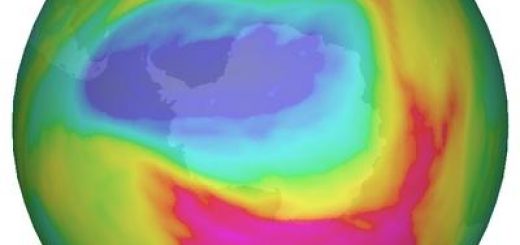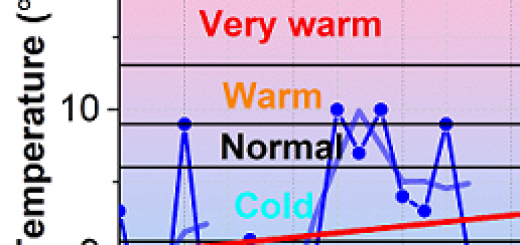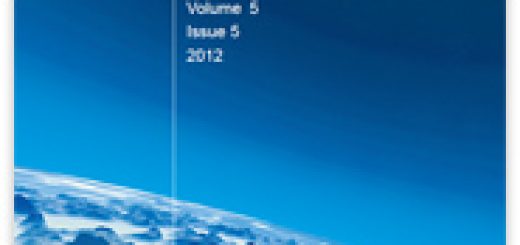International Day for the Preservation of the Ozone Layer
In 1987 representatives of 24 countries met in Montreal to announce to the world that it was time to stop the depletion of the ozone layer. Through that announcement those countries committed themselves, through the Montreal Protocol on Substances that deplete the Ozone Layer, to put an end to the emission into the atmosphere of those substances that harm the ozone layer. On December 19 1994, the United Nations General Assembly declared September 16 the International Day for the Preservation of the Ozone Layer, commemorating the day on which the Montreal Protocol was signed in 1987.
This year, as every year since the 80s, the hole in the ozone layer has appeared in the Antarctic, from the end of August until its recovery in December. Although the process is still taking place, it is, so far, less extensive and seems less intensive than in previous years.
At present, the evolution of the ozone layer is closely linked to climate change. The Montreal Protocol has been a success and has drastically reduced the concentration of substances harmful to ozone. However, the news is that it would seem we cannot go back to exactly where we were before the appearance of the hole in the ozone layer because the atmosphere has changed a lot in the last decades as a result of climate change. Numerical models foresee a recovery of the ozone layer and a return to values prior to the hole around 2050, but recovery of the layer will not be uniform; while at middle latitudes there may even be ‘over-recovery’, at tropical latitudes the models foresee a drop. In the Canaries the predicted change is minor, as was the effect of the drop in the ozone layer, but we are beginning to see how the vertical distribution of ozone is changing. It is dropping in the low stratosphere (at around 12-18 km), while it is rising in the high stratosphere (above 25 km), just as the numerical models predict.
The Izaña Atmospheric Research Center (CIAI) has greatly contributed to the observation and study of the ozone layer, and continues to do so. In May 1991 a program was started to measure the total ozone column by means of ultraviolet spectrophotometry, and a year later (November 1992) the ozonesonde monitoring program was launched in Santa Cruz de Tenerife, which allows us to see the evolution of vertical ozone distribution in the atmosphere up to about 34 km in altitude. Both programs are currently active and are part of both the World Meteorological Organization (WMO) Global Atmospheric Watch Program (GAW) and the prestigious ‘Network for the Detection of Atmospheric Composition Change (NDACC)’. The network has two main aims: to monitor and research ozone and those substances that are harmful to ozone in the stratosphere, the atmospheric region where the ozone layer is found, and to provide calibration and validation platforms for sensors aboard satellites to monitor the ozone layer. Izaña is the only Spanish station belonging to the NDACC.
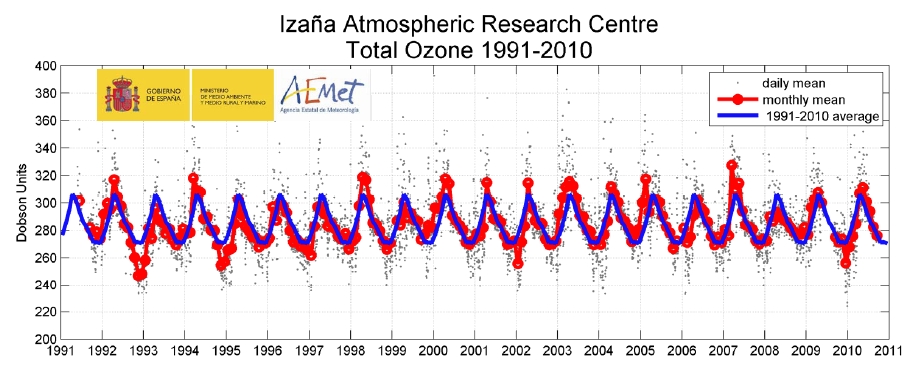
Another relevant activity of the CIAI was the creation (in 2003) and maintenance of the World Meteorological Organization Regional Brewer Calibration Center for Europe – RBCC-E. The Brewer spectrophotometer network is one of two in the world (the other is the Dobson network) for the monitoring and study of the ozone layer at world level. The RBCC-E has the fundamental function of assuring the quality control of the Brewer spectrophotometer network in Europe. Furthermore, and as there is no similar infrastructure in Africa, the RBCC-E cooperates on activities with other countries repairing and calibrating equipment. Thus, collaboration with Morocco and Algeria is particularly active. A Brewer spectrophotometer will soon be installed in the latter, in the heart of the Sahara (Tamanrasset). The RBCC-E also participates in the development of new methodology and in the validation of other techniques (DOAS and FTIR) to measure ozone at the Izaña Atmospheric Observatory itself, in cooperation with the INTA and the Institute for Meteorology and Climate Research (IMK, Germany). In addition, the center takes part in projects financed by the space agencies (NASA and ESA) to carry out sensor calibration campaigns to monitor ozone from both ground and satellite based sensors. Another relevant contribution is that Alberto Redondas, head of the CIAI Ozone and UV Radiation Program, belongs to the WMO Scientific Advisory Group on Ozone (SAG-Ozone).
Our Agency, AEMET, complements this activity with operational monitoring of the ozone layer in Spain with a national Brewer spectrophotometer network and an ozone monitoring station in Madrid.
What can we say today, September 16 2010, about the hole in the ozone layer? Our observation network in the Antarctic (see the ozone series from the Marambio-Antarctic station) already detects episodes of total column ozone at less than 220 Dobson units, the threshold at which we are considered to have an ‘ozone hole’ (marked by a red horizontal line). However, it would seem that, for the moment, the values registered are not as low as for previous years, and that values lower than 220 DU are registered a little later. It would also seem that the presence of polar stratospheric cloud (PSC), which contributes to the destruction of ozone, is less this year. However, the extent and intensity of the hole in the ozone layer are closely linked to polar vortex meteorological conditions, which may vary substantially in the coming weeks, and so it is too soon to make an accurate diagnosis of this year’s situation.
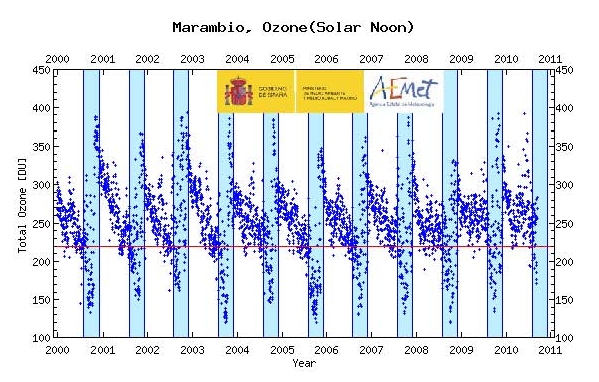
Total ozone series from the Marambio-Antarctic station until September 2010
The following image shows the Temis (Tropospheric Emission Monitoring Internet Service) forecast of the hole in the ozone layer for September 16 2010 (ECMWF-MACC-ESA).
See link for forecasts for subsequent days.


This picture shows the forecast of the ‘hole in the ozone layer’ for September 16 2010 by TEMIS (ECMWF-MACC-ESA)
To know more about the present situation of the ozone layer, you can download the following document: “Executive Summary of the Scientific Assessment of Ozone Depletion 2010 and accompanying press release for issuance on the International Day for the Preservation of the Ozone Layer on 16 September 2010”

